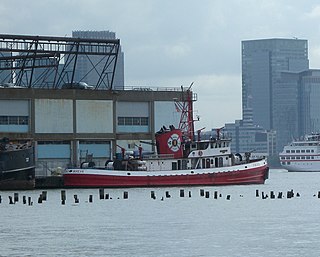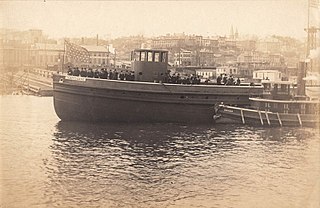Related Research Articles

The New York City Fire Department, officially the Fire Department of the City of New York (FDNY), is a department of the government of New York City that provides fire protection, technical rescue services, primary response to biological, chemical, and radioactive hazards, and emergency medical services responses to the five boroughs of New York City.

A fireboat is a specialized watercraft with pumps and nozzles designed for fighting shoreline and shipboard fires. The first fireboats, dating to the late 18th century, were tugboats, retrofitted with firefighting equipment. Older designs derived from tugboats and modern fireboats more closely resembling seafaring ships can both be found in service today. Some departments would give their multi-purpose craft the title of "fireboat" also.

John J. Harvey is a fireboat formerly of the New York City Fire Department in New York City, famed for returning to service following the September 11, 2001 attacks. She is among the most powerful fireboats ever built, capable of pumping up to 18,000 gallons of water a minute.

Edward M. Cotter is a fireboat in use by the Buffalo Fire Department at Buffalo, New York, United States. Originally named William S. Grattan, she was built in 1900 by the Crescent Shipyard of Elizabeth Port, New Jersey. Due to age she was rebuilt in 1953 and renamed Firefighter upon her return to service. The following year she was renamed Edward M. Cotter. Her namesake, Edward Cotter, was a Buffalo firefighter and leader of the local firefighters union who had recently died.

William M. Feehan was a member of the Fire Department of New York who died during the collapse of the World Trade Center during the September 11 attacks.

Fire Fighter is a fireboat which served the New York City Fire Department from 1938 through 2010, serving with Marine Companies 1, 8 and 9 during her career. The most powerful diesel-electric fireboat in terms of pumping capacity when built in 1938, Fire Fighter fought more than 50 major fires during her career, including fires aboard the SS Normandie in 1942 and the SS El Estero in 1944, the 1973 collision of the Esso Brussels and SS Sea Witch, and the terrorist attacks on September 11, 2001.

John D. McKean is a fireboat that served the New York City Fire Department as Marine Company 1. She is named after John D. Mckean, who died in a 1953 steam explosion while trying to save a predecessor fireboat, the George B. McClellan.
Sea Witch was a MARAD Type C5-S-73b container ship built at the Bath Iron Works shipyard for American Export-Isbrandtsen Lines. She operated in the Atlantic trades for five years. So engaged on the evening of June 1, 1973, the vessel was involved in a disastrous collision with the oil tanker Esso Brussels in lower New York Harbor and was damaged so badly that she was removed from active service.

The Christopher Wheatley is a fireboat delivered to the Chicago Fire Department in 2011. When she was delivered in April 2011, she was the first new fireboat to serve the city in sixty years. She replaced the Victor L. Schlaeger.

The Abram S. Hewitt was a coal-powered fireboat operated by the Fire Department of New York City from 1903 to 1958. She was the department's last coal-powered vessel and had a pumping capacity of 7,000 gallons per minute.
The John P. Devaney was a fireboat operated briefly by the Fire Department of New York City in 1994. The boat was named after a firefighter who lost his life in the line of duty.

The Seth Low was a fireboat built for the Brooklyn Fire Department in Brooklyn, New York, which operated from 1885 to 1917. Prior to her commissioning the Brooklyn Fire Department had relied on fireboats from neighboring municipality New York City. Unlike her opposite number of the New York City Fire Department (FDNY), which had hulls of iron, or steel, the Seth Low was a wooden hulled vessel.
William M. Feehan is a fireboat built for and operated by the New York City Fire Department (FDNY). Her namesake, William M. Feehan, was the oldest and most senior FDNY firefighter to perish in the line of duty on September 11, 2001. Her nameplate is carved from a steel plate salvaged from the collapse of the World Trade Center. The vessel's $4.7 million cost was largely covered by a FEMA Port Security Grant Program.
The Fire Department of New York operated the fireboat Smoke II from 1958 to 2008.

The Kevin C. Kane was formerly an FDNY fireboat and is currently being refitted as a long-haul tugboat. She was commissioned in 1992, participated in two high-profile events: responding to al Qaeda's attack on the World Trade Center, on September 11, 2001; the rescue of airline passengers from the airliner that landed on the Hudson River. She was auctioned off after she incurred damage during Hurricane Sandy. The vessel was named after a firefighter who lost his life in the line of duty.

The George B. McClellan was a fireboat operated by the FDNY from 1904 to 1954. She was designed by Harry deBerkley Parsons, as were other FDNY fireboats built at the time.

The Fire Department of New York operated a fireboat named William J. Gaynor from 1914 to 1961.
The John Purroy Mitchel was a fireboat operated by the FDNY. She was named after former mayor of New York City, John Purroy Mitchel. Grace Drennan, niece of Fire Commissioner Thomas J. Drennan played a ceremonial role in the vessels launch on July 24, 1921. Her launch was also attended by current mayor John Francis Hylan.

The James Duane was a fireboat operated by the Fire Department of New York from 1908 to 1959.

Governor Alfred E. Smith was a fireboat first operated by the Fire Department of New York in 1961. She was the last of four sister ships. In 1970 the Department planned to retire her, but, instead, she was placed in reserve. She was finally retired on October 21, 2016.
References
- 1 2 3 4 Brian J. Cudahy (1997). "Around Manhattan Island". Fordham University Press. pp. 112–114. ISBN 9780823217618. Archived from the original on 2016-03-04. Retrieved 2015-06-29.
- 1 2 George James (1991-03-06). "Often a Hero, a Firefighter Dies on the Job". The New York Times . p. B1. Archived from the original on 2015-05-25. Retrieved 2020-02-08.
Mr. Ronaldson, the 36-year-old son of a retired fire captain and the father of five children, was the first firefighter to die in the line of duty in two years.
- ↑ "New York FDNY Historic Fireboats". www.capecodfd.com. Archived from the original on 2019-06-20. Retrieved 2019-10-25.
| This article about a specific civilian ship or boat is a stub. You can help Wikipedia by expanding it. |